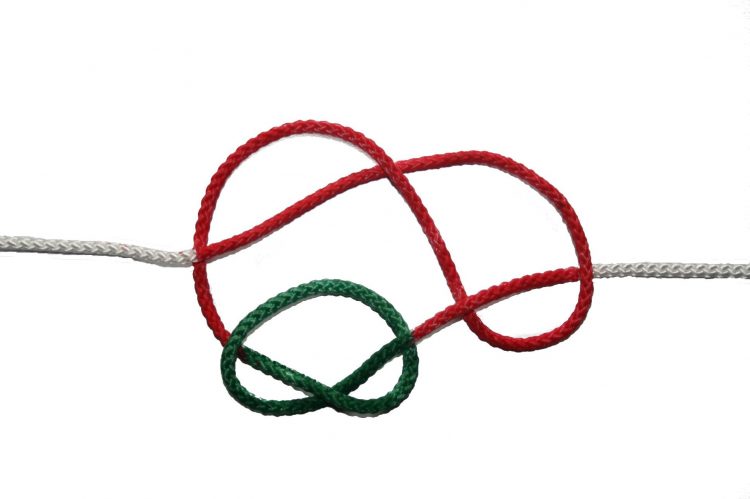How knots can swap positions on a DNA strand

Schematic representation of the swapping event: one of the knots grows in size, while the other diffuses along the contour of the former. ill./©: Peter Virnau, JGU
Physicists of Johannes Gutenberg University Mainz (JGU) and the Graduate School of Excellence “Materials Science in Mainz” (MAINZ) have been able with the aid of computer simulations to confirm and explain a mechanism by which two knots on a DNA strand can interchange their positions.
For this, one of the knots grows in size while the other diffuses along the contour of the former. Since there is only a small free energy barrier to swap, a significant number of crossing events have been observed in molecular dynamics simulations, i.e., there is a high probability of such interchange of positions.
“We assume that this swapping of positions on a DNA strand may also happen in living organisms,” explained Dr. Peter Virnau of the JGU Institute of Physics, who performed the computer simulation together with his colleagues Benjamin Trefz and Jonathan Siebert.
The scientists expect that the mechanism may play an important role in future technologies such as nanopore sequencing, where long DNA strands are sequenced by being pulled though pores. Long DNA strands of more than 100,000 base pairs have an increasing chance of knots, which is relevant for sequencing.
Publication:
Benjamin Trefz, Jonathan Siebert, Peter Virnau
How molecular knots can pass through each other
Proceedings of the National Academy of Sciences, 19 May 2014
DOI:10.1073/pnas.1319376111
http://www.pnas.org/content/111/22/7948.abstract
Further information:
Dr. Peter Virnau
Condensed Matter Theory Group (KOMET)
Institute of Physics
Johannes Gutenberg University Mainz (JGU)
D 55099 Mainz, GERMANY
phone +49 6131 39-20493
fax +49 6131 39-20496
e-mail: virnau@uni-mainz.de
http://www.komet331.physik.uni-mainz.de/virnau.php
http://www.uni-mainz.de/presse/17448_ENG_HTML.php – press release
Media Contact
All latest news from the category: Life Sciences and Chemistry
Articles and reports from the Life Sciences and chemistry area deal with applied and basic research into modern biology, chemistry and human medicine.
Valuable information can be found on a range of life sciences fields including bacteriology, biochemistry, bionics, bioinformatics, biophysics, biotechnology, genetics, geobotany, human biology, marine biology, microbiology, molecular biology, cellular biology, zoology, bioinorganic chemistry, microchemistry and environmental chemistry.
Newest articles

A universal framework for spatial biology
SpatialData is a freely accessible tool to unify and integrate data from different omics technologies accounting for spatial information, which can provide holistic insights into health and disease. Biological processes…

How complex biological processes arise
A $20 million grant from the U.S. National Science Foundation (NSF) will support the establishment and operation of the National Synthesis Center for Emergence in the Molecular and Cellular Sciences (NCEMS) at…

Airborne single-photon lidar system achieves high-resolution 3D imaging
Compact, low-power system opens doors for photon-efficient drone and satellite-based environmental monitoring and mapping. Researchers have developed a compact and lightweight single-photon airborne lidar system that can acquire high-resolution 3D…





















